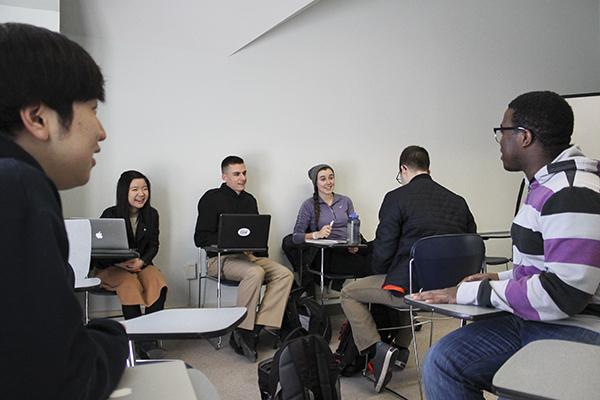University Writing professors are teaching larger classes this semester, which they say translates into less time for giving personalized feedback to students.
The enrollment cap for each UW section rose to 17 students this spring, allowing the program to offer fewer classes and cut costs, Derek Malone-France, the program’s executive director, said last week. That’s forced faculty to rework how they teach classes and could mean some instructors won’t be back at GW next year.
The increase from 15 students per section, which means each professor now teaches about six additional students, leaves less time to work one-on-one, several faculty members said. That personalized instruction is a major part of the program, which is often GW students’ first introduction to college-level research, they said.
As GW’s undergraduate population has grown, faculty have had to teach more sections per semester, but Malone-France said the program has typically hired more instructors to teach “overload classes” so it could offer enough sections to meet demand while keeping the number of students in each class at the same level.
“We will not be requesting such overloads with the increased class enrollment cap,” he said in an email.
He did not respond to questions about how many fewer course sections would be offered in the fall or how many fewer faculty members would be needed for the program.
Phyllis Ryder, an associate professor of writing who has been a part of the program since its inception in 2003, said her personal meetings with students were integral to the writing process, as were discussion sessions with small groups of students that would lead.
In the past, she would cancel class for two weeks to have individual workshops during class time during one week, and group workshops that she led during the other. But since she can’t cancel eight classes for both the group and personal workshops, her students’ writing this spring isn’t receiving as much professional attention, she said.
Ryder teaches a service-learning course, where students work with a local organization and write papers about how to support that organization.
“It changed the way I teach the class,” she said. “The students will be writing drafts expecting to be published in undergraduate journals. So they’re still trying to get a sense of the public audience, but they’re not anticipating the needs of the organization.”
Ryder added that she typically used to spend 45 minutes to an hour grading each students’ paper. By taking on six more students, she said she will now roughly spend an extra day on grading.
While officials have presented the challenges to faculty as an emergency situation, there’s a sense that the changes will last until at least next year, said Danika Myers, a teaching instructor in the UW program. She said it could be difficult to shrink class sizes after the University finds that it is saving money.
“It’s a lot harder to decide to roll it back, so we don’t know what’s going to happen,” she said. “Optimistically, this is an emergency situation and perhaps we can get back closer to the ideal that students can get the one-on-one attention.”
Every freshman at GW is required to take a UW course. The program, which is housed in the Columbian College of Arts and Sciences, has seen its budget tighten for the past year because of graduate enrollment declines. Other departments didn’t hire back some adjunct faculty for this year, and the college launched fewer national searches for new professors.
When the UW program launched over a decade ago, faculty taught two sections of 15 students each semester. Most faculty now teach three sections with a maximum of 17 students in each.
The total number of sections and seats per section that will be offered in the future will be determined by the number of students who need to complete the course, said Ben Vinson, dean of the Columbian College.
“Modestly raising the enrollment cap allows the Columbian College of Arts and Sciences to continue to keep classes small while containing costs associated with adding extra class sections,” Vinson said in an email.
Another UW professor, who spoke on the condition of anonymity because the topic is sensitive, said nearly every UW course had to be redesigned between the fall and spring semesters. The professor said the writing course is one of the only chances for undergraduates to formulate their own research questions and contribute to the production of new knowledge, but that requires intensive revisions with the guidance of a professor.
Because faculty are working with more students, either their personal research or their interactions with students will be affected, the professor said.
“You just can’t do both with these kinds of conditions, and either way, the faculty experience suffers and the student experience suffers along with it,” the professor said.
For a few faculty members, like teaching assistant professor Katherine Larsen, the student cap on the Mount Vernon Campus for classes held on Tuesdays and Thursdays prohibited their class sizes from growing by as many students. Still, those additional students add up, she said, and all faculty members are struggling to find time to meet with students and also put enough time into grading.
Larsen, who is also a member of the Faculty Association’s steering committee, said some course-by-course instructors who aren’t protected by an adjunct union fear that they might not be hired back next year. She said losing some of those faculty would be discouraging for the department.
“We can’t continue to do the really good work that we’re doing with students when we’re asked to do it for so many more and not have something slip along the way,” she said.







